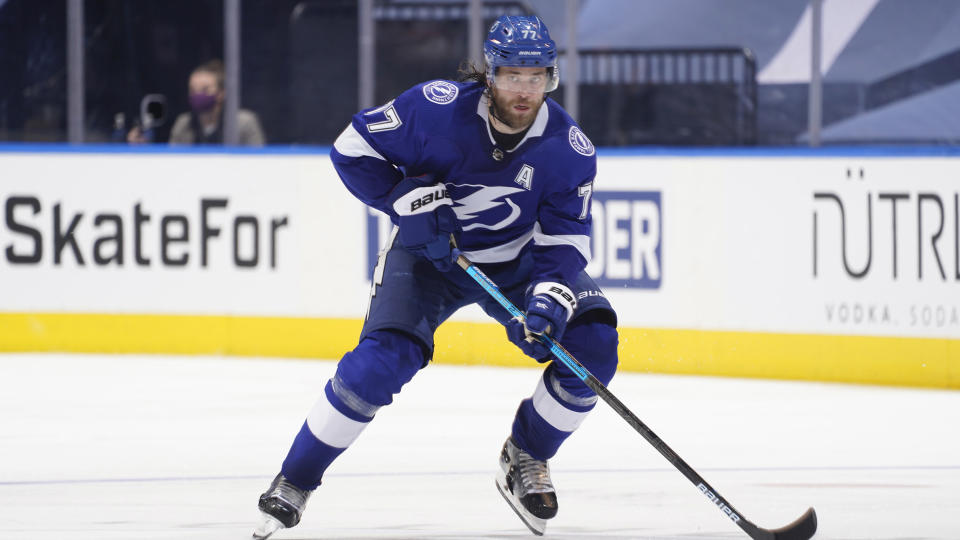Victor Hedman dictating Stanley Cup Final in deep-lying playmaker role
Entering the Stanley Cup Final, the Tampa Bay Lightning and Dallas Stars both carved out distinct identities. Tampa Bay marched forward as a relentless shot-creation machine with tremendous lineup flexibility and the ability to play any type of game, while its star-studded core operated at the height of its powers. Dallas emerged as a defensive-minded club that relied on elite goaltending, counterattacking from its top defensemen and a stacked top forward group to generate chances.
These narratives for the most part have played out as expected, but through three games it has been of paramount importance for defensemen to enter the rush and create scoring chances, with two teams that are diligent at suppressing prime scoring opportunities.
Victor Hedman is the likely leader for the Conn Smythe Trophy and is in the middle of a historic postseason run. Hedman is undoubtedly an excellent defensive presence but he’s operating as a deep-lying playmaker throughout the postseason, boasting elite long-range passing, vision and the anticipation of when to aggressively pinch or join the rush.
With 10 goals, Hedman’s proficient scoring has been rightly highlighted but he’s an all-world dynamo who evokes comparisons to the best soccer midfielders. Consider an amalgamation between Luka Modric and Kevin De Bruyne, add roughly 10 inches in height with skates on, slightly more pace and you have an archetype for Hedman’s rare skillset.
SEEN STAMKOS? 🔥🔥🔥 pic.twitter.com/mwgc3YhJFq
— Tampa Bay Lightning (@TBLightning) September 24, 2020
Let’s take a look at Steven Stamkos’s goal in Game 3. Stamkos deserves all the credit in the world for a picture-perfect finish, and his return to the Final after a seven-month absence might be the coolest storyline of the playoffs. Before Stamkos works his magic, it is Hedman’s instant read that sets up the goal.
Hedman receives a quick feed off the boards from Jan Rutta, corrals the puck, spins, and surveys the ice in one motion. He identifies that the normally positionally sound Esa Lindell takes a terrible angle to Stamkos, who accelerated past Tyler Seguin the instant Rutta won back the puck. As Seguin fails to assess the danger of the scenario before it’s too late, Stamkos easily sidesteps Lindell, then bursts in on net, depositing the puck into the corner with the accuracy and speed we’ve come to expect from a former 60-goal scorer. Tossing the puck through the middle of the ice is often a careless play but it arrived on point with perfect touch and accuracy. Advantage, Hedman.
🚨 Brayden Point
4-1 #GoBolts pic.twitter.com/wwivRseA9q— Here's Your Replay ⬇️ (@TheReplayGuy) September 24, 2020
Tampa’s fourth goal in Game 3 might be a simpler example of Hedman’s long-range passing. Although Hedman is out of frame, he immediately recognizes that the Stars are caught on a line change and springs Nikita Kucherov on an instant 3-on-1. Kucherov, Ondrej Palat and Brayden Point posted an absurd 96 percent share of the expected goals during the second period and they deserve plaudits for slicing up the Stars in both of their wins. The NHL’s most potent line only needs a sliver of space to execute but Hedman rightly deserves credit for taking advantage of the Stars’ breakdown here.
🚨 Victor Hedman PP
3-1 #GoBolts pic.twitter.com/88aIZEccJV— Here's Your Replay ⬇️ (@TheReplayGuy) September 24, 2020
Hedman inherently understands when to jump into the offense or when to insert himself into a high-danger area. During the Lightning’s power play, the Stars commit three players to a loose puck battle against the boards, deep in their own zone. Joe Pavelski, the lone Stars player who doesn’t commit to the puck pursuit, completely loses track of Hedman, who slides down into the slot. Anthony Cirelli digs the puck out for the Lightning, finds Hedman while Pavelski’s rotation is too late and it’s 3-1.
It’s not just Hedman who understands the importance of joining the rush. If the Stars are to wrestle this series back from the Lightning, despite far inferior possession and shot quality statistics thus far, they will have to replicate their formula from Game 1. Dallas did three things particularly well despite being out-possessed and failing to stop Tampa from generating chances: it created more high-danger scoring chances (8-6), it restricted Tampa from creating opportunities through the middle, and its defensemen didn’t hesitate to supplement the attack. In fairness, this may be underrating Anton Khudobin’s outstanding Game 1 performance.
John Klingberg is one of the NHL’s best offensive defensemen but he had a rare rough night in Game 1, where his colleagues picked up the slack. Jamie Oleksiak (71.8%) and Miro Heiskanen (62.4%) both dominated the share of expected goals, while Joel Hanley (50%) made an instant impact with his first career marker.
Joel Hanley's first #StanleyCup Playoff goal is both nice and the Shot of the Night!
NHL x @JagermeisterUSA pic.twitter.com/WskcaaHDas— NHL (@NHL) September 20, 2020
Hanley will always remember his first goal, even it was largely the result of calamitous decision-making by Zach Bogosian. Joel Kiviranta finishes his check on Point and the puck squirts loose behind the net. Instead of picking up the open man, Bogosian inexplicably heads to the boards to retaliate against Kiviranta, allowing Roope Hintz to scoop up the loose puck and take his time to survey his options. Hanley correctly interprets that Point isn’t there to pick him up, Bogosian is out of the play entirely, Ryan McDonagh tries to block off any passing lanes in front of the net, while Alex Killorn takes a crashing Corey Perry. In the slot, with nothing but time, Hanley picks the top corner for the opening goal.
BACK. ON. TOP!
Jamie Oleksiak puts #GoStars up by 1️⃣. pic.twitter.com/hWOx53u8kt— #StanleyCup Final on NBC (@NHLonNBCSports) September 20, 2020
Oleksiak was awesome in Game 1, and his goal requires a much simpler explanation. Alex Radulov holds the puck, along with the attention of three Lightning defenders, as Jamie Benn looks to wire a potential feed from inside the faceoff circle. Point, who should ideally close out Oleksiak, passively watches the play as he walks in. Luke Schenn blocks Oleksiak’s initial shot but is completely out of the play, and the original three Lightning players who converged on Benn have little time to get over to the other side, as Oleksiak picks up his own rebound for the go-ahead goal.

Hedman isn’t the only Lightning defenseman capable of creating key scoring chances. McDonagh (64.4%), Erik Cernak (62.9%), Mikhail Sergachev (59.9%), Rutta (59.6%), Hedman (53.1%) and Kevin Shattenkirk (53.1%) hold a majority share of expected goals at 5-on-5, according to Natural Stat Trick, while Sergachev (36), Hedman (35) and Shattenkirk (33) have created a ton of unblocked shot attempts through three games. At his zenith, Hedman’s ability to orchestrate the game from the back end while possessing an elite scoring touch makes him the postseason MVP, but it’s clear that his teammates share his philosophy.
If Hedman evokes comparisons to a taller De Bruyne, then Heiskanen is hockey’s answer to Alphonso Davies. Of course, there are limitations to any cross-sport comparison— the average soccer field is about 100 feet wider, for example, while Hedman really functions as a hybrid No. 6 and 10 at once — but Heiskanen’s world-class speed and vision are the focal points of his game, along with his ability to enter the rush without sacrificing anything defensively. He’s also rapidly improving as a playmaker.
Heiskanen hasn’t slipped under the radar in the past but this has been a true breakout performance throughout the playoffs. In Game 3, Heiskanen made his first major mistake of the postseason, tossing the puck up to Kucherov, who tucked it away for the contest’s opening goal. It shouldn’t overshadow what’s been a brilliant campaign to date. If the Stars are to get back into the series, it may be on Heiskanen to emulate the best elements of Hedman’s game and trust his otherworldly speed to dictate more chances.
Midway through the series, Hedman’s playmaking has vaulted him into historic territory and while the ratings are down, these two teams have made the Stanley Cup Final a worthwhile endeavor. If it truly takes all hands on deck to lift the Cup, it may come down to which team’s defensemen step up offensively.
More NHL coverage from Yahoo Sports

 Yahoo Sports
Yahoo Sports 


